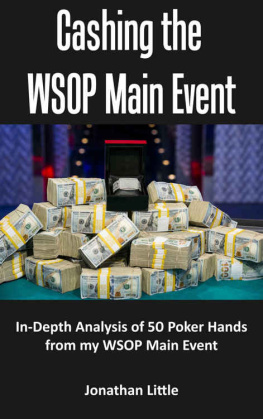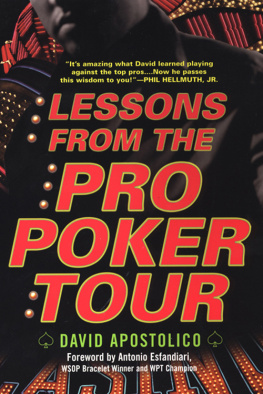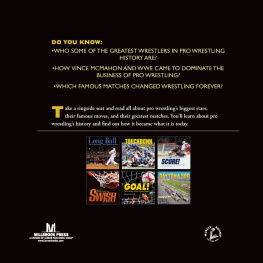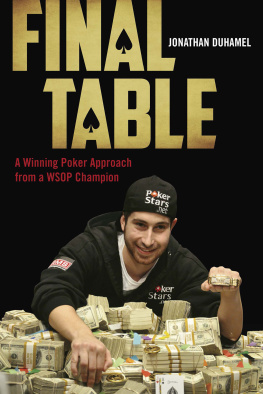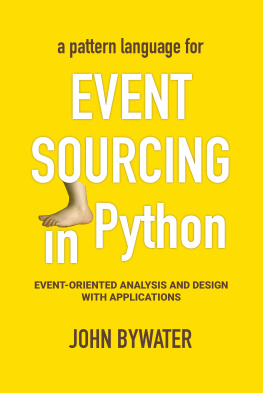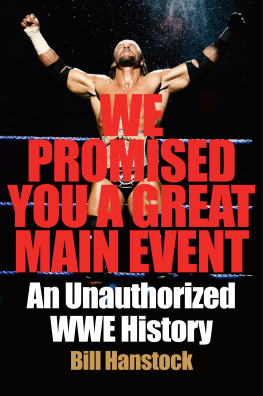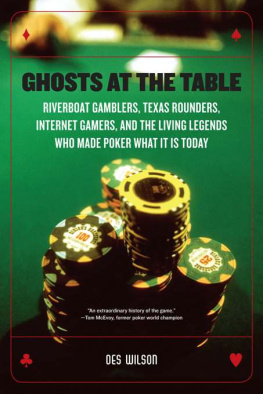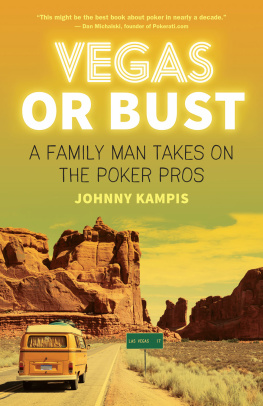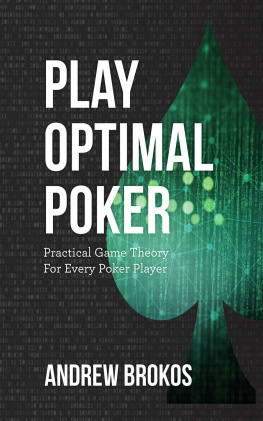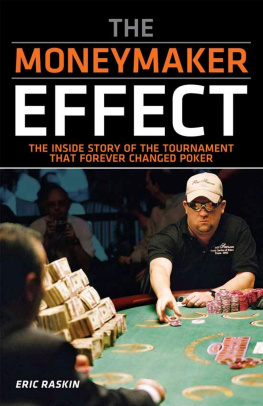Jonthan Little - Cashing the Wsop Main Event: In-Depth Analysis of 54 Poker Hands from My Wsop Main Event
Here you can read online Jonthan Little - Cashing the Wsop Main Event: In-Depth Analysis of 54 Poker Hands from My Wsop Main Event full text of the book (entire story) in english for free. Download pdf and epub, get meaning, cover and reviews about this ebook. year: 2014, publisher: Jonathan Little, genre: Detective and thriller. Description of the work, (preface) as well as reviews are available. Best literature library LitArk.com created for fans of good reading and offers a wide selection of genres:
Romance novel
Science fiction
Adventure
Detective
Science
History
Home and family
Prose
Art
Politics
Computer
Non-fiction
Religion
Business
Children
Humor
Choose a favorite category and find really read worthwhile books. Enjoy immersion in the world of imagination, feel the emotions of the characters or learn something new for yourself, make an fascinating discovery.
- Book:Cashing the Wsop Main Event: In-Depth Analysis of 54 Poker Hands from My Wsop Main Event
- Author:
- Publisher:Jonathan Little
- Genre:
- Year:2014
- Rating:3 / 5
- Favourites:Add to favourites
- Your mark:
- 60
- 1
- 2
- 3
- 4
- 5
Cashing the Wsop Main Event: In-Depth Analysis of 54 Poker Hands from My Wsop Main Event: summary, description and annotation
We offer to read an annotation, description, summary or preface (depends on what the author of the book "Cashing the Wsop Main Event: In-Depth Analysis of 54 Poker Hands from My Wsop Main Event" wrote himself). If you haven't found the necessary information about the book — write in the comments, we will try to find it.
Jonthan Little: author's other books
Who wrote Cashing the Wsop Main Event: In-Depth Analysis of 54 Poker Hands from My Wsop Main Event? Find out the surname, the name of the author of the book and a list of all author's works by series.
Cashing the Wsop Main Event: In-Depth Analysis of 54 Poker Hands from My Wsop Main Event — read online for free the complete book (whole text) full work
Below is the text of the book, divided by pages. System saving the place of the last page read, allows you to conveniently read the book "Cashing the Wsop Main Event: In-Depth Analysis of 54 Poker Hands from My Wsop Main Event" online for free, without having to search again every time where you left off. Put a bookmark, and you can go to the page where you finished reading at any time.
Font size:
Interval:
Bookmark:
Cashing the WSOP Main Event In-Depth Analysis of 54 Poker Hands from my WSOP Main Event By Jonathan Little Copyright 2014 Jonathan Little All rights reserved. www.JonathanLittlePoker.com
Acknowledgments This book would not exist if I did not have an amazing team of people working with me on a regular basis. Dan Stanley turns all of my ideas into reality. My parents, Larry Little and Rita Little, along with Ken Adams, diligently proofread this book, which was initially littered with typos. Amie Broder tirelessly supports me and calms me down when I am overly hyper, bouncing off the walls with ideas spewing out of my mind. I would like to thank you, the reader of this book.
Without my dedicated poker students, none of this would be possible. Table of Contents Ninety percent of the hands arent shown in a poker game. -Doyle Brunson
In order to win all of the chips in a 6,683 person tournament, you simply must take some risks and try to accumulate some chips. The WSOP Main Event is perhaps the deepest stacked event of the year. This means the blinds remain relatively small compared to the effective stack size throughout the entire tournament. While the average chip stack in most small stakes local tournaments is frequently 20 big blinds or less, in the Main Event, the average stack size starts out at over 200 big blinds and remains at around 80 big blinds until the final table. This results in excellent poker players having a huge advantage because more money will go into the pot on later streets when the excellent players have a better idea of how their hand will fare. It is a common misconception among amateur players that deep stacks allow them to play for a longer period of time with less risk.
While the amateurs will get to sit at the table for a longer period of time than they normally do, their equity is demolished by strong players who are not afraid to get a bit out of line in a calculated manner, allowing them to steal most of the pots when their amateur opponent does not have a premium holding. Please note that this book is not geared towards total novices. If you are an amateur poker player with a reasonable amount of experience, you will likely be surprised at how aggressively I go after small pots while being able to get off the hook in situations many players would normally consider unavoidable. Please read this book with an open mind. If you have any questions, I strongly urge you to post them in my poker forum at FloatTheTurn.com . How I Record My Live Hands Whenever I play a major live event, I make a point to take diligent notes on every situation I encounter.
While I will not review every single hand I played in the Main Event, mainly because most of them are fairly standard and inconsequential, I will review every decision I think is worthy of in-depth discussion. I have a fairly unique way of taking notes, although many diligent players have started copying my method. I have prepared a video tutorial for you to study how I take notes on my personal blog found here . If you dont feel like watching the video, I will explain the process. I bring a small spiral-bound notebook to every major tournament. At the top of every page in my notebook, and in this book, I write down my hand (H), my stack size (S), the blinds (B), and my position (P).
I find that frequently I have trouble recalling these details accurately, so I make a point to record them in my notebook before the action begins. After a hand is complete, I write the preflop action, the flop cards, the flop action, the turn card, the turn action, the river card, and the river action. I then note any cards that are revealed at the showdown. Once I have finished writing down a hand, I occasionally scribble down any thoughts I had that swayed my decision one way or the other. I strongly suggest you start writing down any tricky situation, as well as some of the mundane ones that you encounter at the poker table. Discussing these situations with your peers and poker coach will greatly improve your game.
You will likely discover that, with practice, writing down hands becomes second nature. I promise, it is not too difficult to get the hang of it once you experiment with it a bit. I will discuss all of my thoughts on each and every betting round. When playing a hand, you have to assign your opponents a range of hands and slowly narrow it down as the hand progresses. While I will often outline the general range I think my opponent has on each betting round, try to assign ranges on your own and see if you come up with the same conclusions I do. I decided to modify my notes into a quiz format so you can test yourself whenever I have a decision to make.
The purpose of asking you questions is to get you in the habit of thinking about all of your options and picking the best one. While your options are almost limitless in no-limit holdem, you will find that, most of the time, only one or two plays are actually acceptable. That being said, I made quite a few errors throughout the tournament. When I make a bad play, I will make it clear. There is no scoring system because you are not competing with anyone. Remember, I want to get you in the habit of thinking about all of your options and assessing ranges.
Please do not mindlessly speed through this book. You will miss a lot of value. I make a point to label my opponents using various descriptive terms. A tight passive (TP) player will play relatively few hands before the flop, usually in a passive manner. When these players raise or reraise, you should assume they have a strong holding most of the time. A loose passive (LP) player is someone who frequently limps in before the flop but rarely applies aggression without a strong hand.
A tight aggressive (TAG) player plays mostly strong starting hands but aggressively tries to win most pots he enters. A loose aggressive (LAG) player plays a wide range of preflop starting hands and usually applies significant aggression whenever he thinks he can steal the pot or extract additional value. A maniac is someone who is attacking most pots in an overly aggressive manner. A calling station is someone who does not comprehend that he should fold when he doesnt have at least a reasonable hand if he is facing aggression. Someone who is splashy tends to try to see a flop with a wide range of hands, usually with no clear idea of how to proceed after the flop. Splashy players typically see too many flops and turns but give up to significant aggression by the river.
My style is somewhere in between TAG and LAG. It is important to not show up to a tournament with a preconceived idea of how you plan to play. The ideal strategy is to see what your opponents will let you get away with then adjust accordingly. I want to make it perfectly clear that playing according to some sort of system or formula will not work in the long run. You must learn to think for yourself and alter your strategies based on your opposition. I use a few terms to describe which seat both my opponents and I are in.
I think most players know who the big blind (BB), small blind (SB), and Button are. The cutoff (CO) is the player to the right of the Button. The hijack (HJ) is the person to the right of the CO. The lojack (LoJ) is the person to the right of the HJ. From there, assuming the table has 9 players, the person to the right of the LoJ is 4 th , the person to the right of 4 th is 3 rd and the person to the right of 3 rd is 2 nd . The player first to act before the flop is under the gun (UTG).
Font size:
Interval:
Bookmark:
Similar books «Cashing the Wsop Main Event: In-Depth Analysis of 54 Poker Hands from My Wsop Main Event»
Look at similar books to Cashing the Wsop Main Event: In-Depth Analysis of 54 Poker Hands from My Wsop Main Event. We have selected literature similar in name and meaning in the hope of providing readers with more options to find new, interesting, not yet read works.
Discussion, reviews of the book Cashing the Wsop Main Event: In-Depth Analysis of 54 Poker Hands from My Wsop Main Event and just readers' own opinions. Leave your comments, write what you think about the work, its meaning or the main characters. Specify what exactly you liked and what you didn't like, and why you think so.

